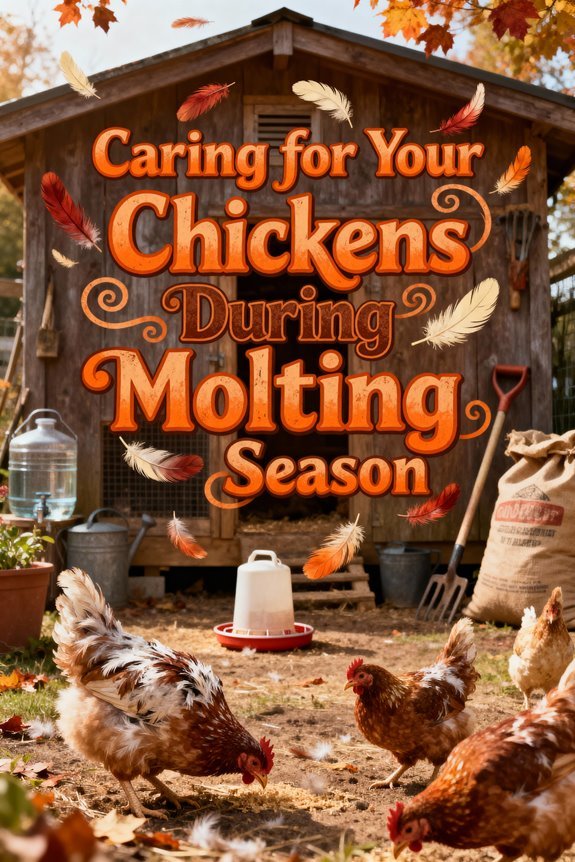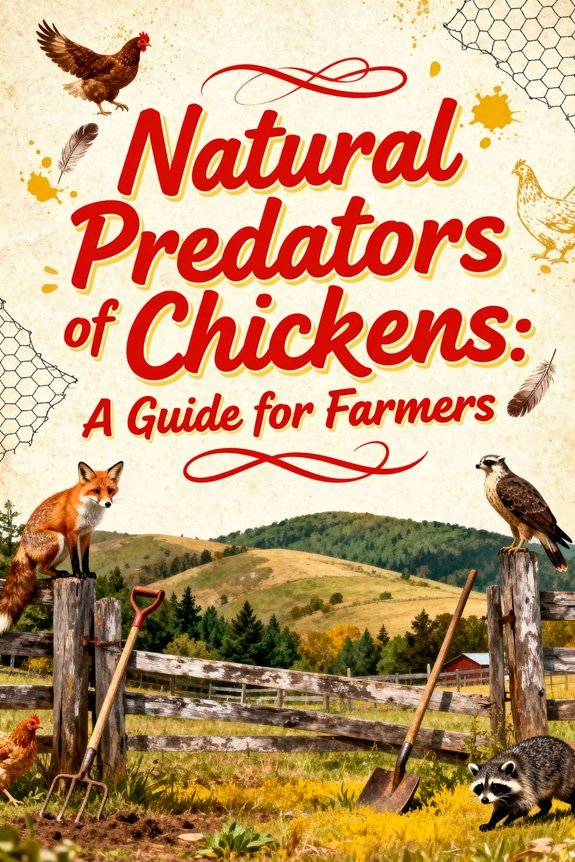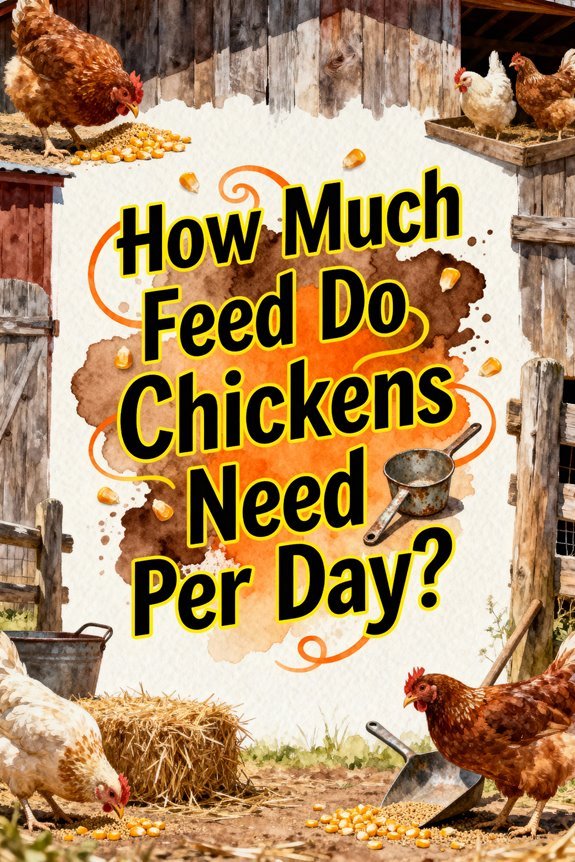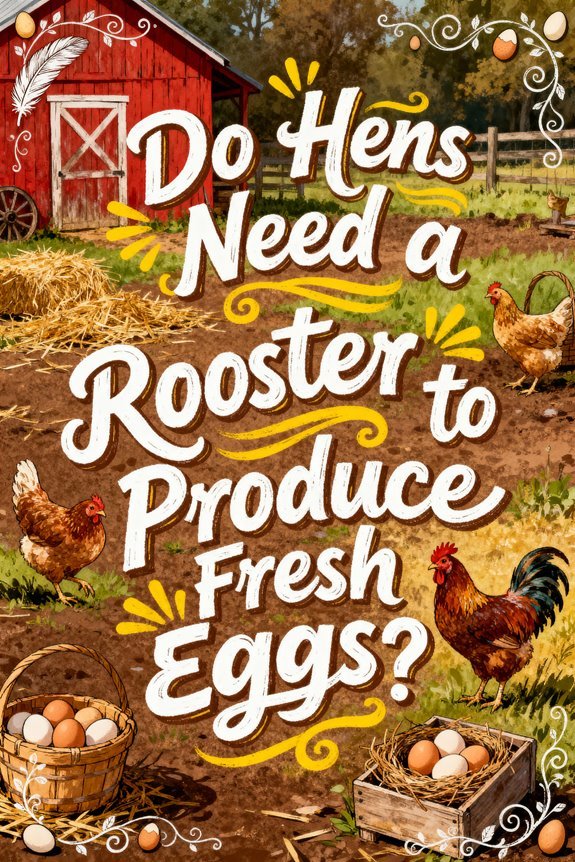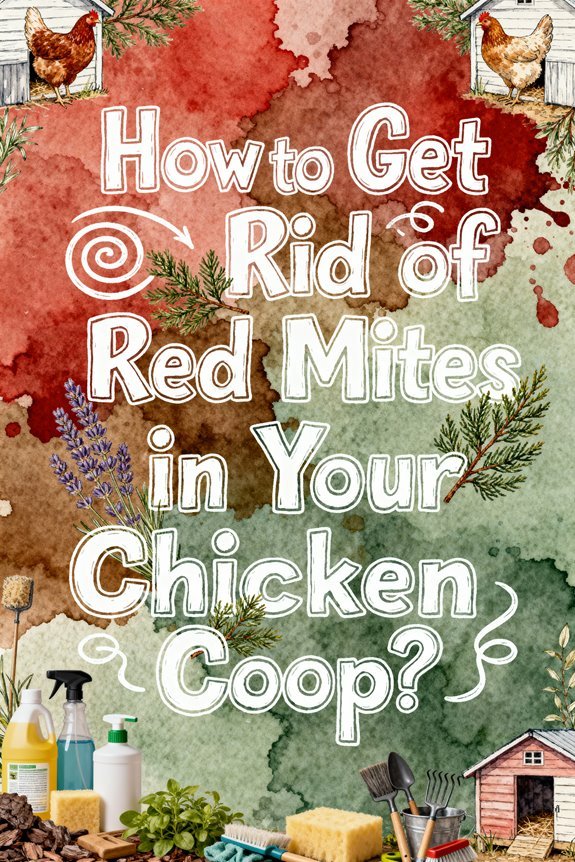Caring for Your Chickens During Molting Season
During molting season, you’ll need to provide your chickens with increased protein (at least 20%) through specialized feeds or supplements to support feather regrowth. Keep their environment stress-free by maintaining consistent routines and minimizing handling. Make sure the coop stays draft-free but well-ventilated, with extra bedding for warmth. Monitor their health closely for signs of parasites or illness, and maintain fresh water access. Proper care during this vulnerable period sets the foundation for healthy feather development.
Understanding the Natural Molting Process
While every chicken owner encounters molting, understanding this natural process is essential for proper care. Your chickens will experience their first juvenile molt at 6-8 days old, followed by a second molt between 7-12 weeks. The first adult molt typically occurs around 16-18 months of age.
During the molting process, you’ll notice feather development follows a specific sequence: head, neck, back, breast, wings, and tail. This cycle, triggered by decreasing daylight in late summer or fall, can last one to six months. Molting triggers can also include environmental stressors like changes in food or water availability. The process is regulated by chickens’ internal circadian clock, which adapts to environmental light patterns throughout their lives. Chickens often experience a catastrophic molt where feathers drop rapidly and leave patchy bare spots. While feather loss around the ears during molting is normal, persistent bare patches may indicate ear mite infestation requiring immediate attention. Your chickens will go through distinct stages, starting with feather loss, followed by sensitive pin feathers, and finally, mature feather growth. Understanding these patterns helps you provide appropriate care during this vulnerable period.
Essential Nutrition During Feather Loss
Because molting chickens require considerably higher protein intake for feather regrowth, adjusting their nutrition during this period is essential for their health and recovery. Switch to feeds containing at least 20% protein, as standard layer rations won’t suffice. Consider using starter-grower or gamebird feeds to meet these elevated needs. Maintaining free feeding access helps ensure birds get adequate nutrition during this challenging phase.
During this time, energy is redirected from egg production to feather growth, making proper nutrition even more crucial. You’ll need to maintain proper caloric intake through healthy fats like sunflower and flaxseeds while ensuring essential vitamins A, D, and E for ideal feather quality. A balanced diet containing essential amino acids is fundamental for healthy feather development. Supplement with protein-rich snacks such as mealworms or black soldier fly grubs, but avoid overfeeding. Monitor your flock’s progress and adjust nutrition accordingly. Once molt ends, gradually shift back to regular layer feed. Remember to provide fresh water consistently, as it’s vital for nutrient transport and metabolism during this demanding period.
Creating a Stress-Free Environment
Since molting causes heightened vulnerability in chickens, creating a stress-free environment becomes essential for their recovery and wellbeing. You’ll need to focus on stress reduction by maintaining consistent daily routines and avoiding sudden changes or disturbances in their environment. The process typically takes 8 to 12 weeks for completion, requiring sustained attention to their comfort. Watch for signs of feather pecking behavior which can worsen during molting due to increased stress levels.
Ensure peaceful surroundings by keeping the coop clean, well-ventilated, and draft-free. Add extra bedding for warmth and comfort during feather loss. While heat lamps are unnecessary and potentially dangerous, pine shavings provide natural insulation during the molting period. Provide multiple hiding spots and quiet areas where birds can retreat when feeling vulnerable. Don’t introduce new flock members during this time, and minimize handling to prevent pain from sensitive pin feathers.
Keep predators at bay by securing the coop and run, as molting chickens are particularly defenseless. Position feeders and waterers strategically to reduce competition and unnecessary movement while they conserve energy for feather regrowth.
Health Monitoring and Protection
As chickens undergo the demanding process of molting, vigilant health monitoring becomes critical for their survival and recovery. You’ll need to check your birds frequently for signs of illness, parasites, and abnormal feather regrowth patterns. Watch for damaged pin feathers, which can bleed and lead to complications. Most chickens experience their first adult molt when they reach 16-18 months old.
Support their immune system by providing high-protein feed (18-22%) and supplements rich in essential amino acids. Since feathers are made of 85% protein, maintaining optimal nutrition is crucial during this stressful period. Implement thorough parasite management by maintaining clean bedding and applying appropriate treatments when needed. Offering natural daylight access helps reduce stress and supports their overall health during molting. Don’t forget to inspect skin and feather bases regularly where parasites typically hide.
Minimize handling during sensitive feather regrowth periods and guarantee proper spacing in the coop. If you notice lethargy, reduced feeding, or respiratory issues, isolate affected birds promptly to prevent disease spread within your flock.
Supporting Temperature Regulation
The delicate process of molting leaves chickens particularly vulnerable to temperature fluctuations due to their reduced feather coverage. Without proper feather insulation, your birds need extra support for effective temperature management during this sensitive period.
You’ll need to maintain consistent coop temperatures using appropriate ventilation and insulating bedding materials like straw. During cold weather, consider using monitored heating systems and encourage flock “sandwiching,” where molting birds nestle between fully-feathered companions. In warm conditions, provide adequate shade and dust bathing areas. Layered straw bedding helps trap valuable body heat and provides essential coop insulation during the molting period.
Support your birds’ temperature regulation through proper nutrition, offering high-protein feeds (18-20%) and supplements to promote feather regrowth. Using crumble feed can improve nutrient absorption and help birds maintain body heat more efficiently. Providing sunflower seeds can offer additional protein and energy support during the colder months. Keep fresh water available, and minimize handling and social stress to help your chickens maintain stable body temperatures throughout their molt.
